In 1964, the U.S. Army sought an armed helicopter for use in Vietnam. The Boeing-Vertol company proposed a heavily armed CH-47 Chinook helicopter, which the U.S. Army quickly accepted. The original agreement called for 11 gunships, but only four were built, as the Chinook was needed for transport duties.
In late 1965, Boeing-Vertol completed four CH-47A Chinook Gunships. The prototype, #64-13145 (Co$t of Living), went to Edwards Air Force Base for flight testing. The other three ships, 64-13149 (Easy Money), 64-13151 (Stump Jumper), and 64-13154 (Birth Control), were assigned to the 10th Aviation Group, Field Evaluation Detachment (Special)(CH-47) (Provisional) at Fort Benning, Georgia.
On January 18, 1966, Lt. Col. William Tedesco took command of the Detachment, and the unit conducted training at Ft. Benning, Redstone Arsenal, and Eglin AFB.
Legend has it that its commander, Lt. Col. Tedesco created the detachment nickname. According to a crew member, one day after testing was done they were eating at a club featuring go-go dancers when Tedesco told them he would pay $25 to the first man to come up with a name for the gunships. One of the crew suggested “Go-Go Girls.” Tedesco thought about it momentarily and said, “We should call them “Guns-A-Go-Go.”
CH-47A Chinook Gunships Dispatched to Vietnam
On April 19th, the unit was redesignated the 53rd Aviation Detachment Field Evaluation (Provisional), nicknamed Guns-A-Go-Go, and ordered to Vietnam for temporary duty at Vung Tau Air Base for three months and An Khe, aka Camp Radcliff, aka The Golf Course, for three months.
Vung Tau Air Base was a Republic of Vietnam Air Force (RVNAF) facility located near the city of Vũng Tàu in southern Vietnam. The base was initially constructed in 1940 and known as Cap St Jacques Airfield. Following the partition of Vietnam in 1954, the French Air Force conducted Grumman F8F Bearcat transition training for the RVNAF at the airfield before leaving for good. In 1961, the U.S. Army began upgrading the base for U.S. forces and the main base for Royal Australian Army and Air Force units serving in Vietnam.
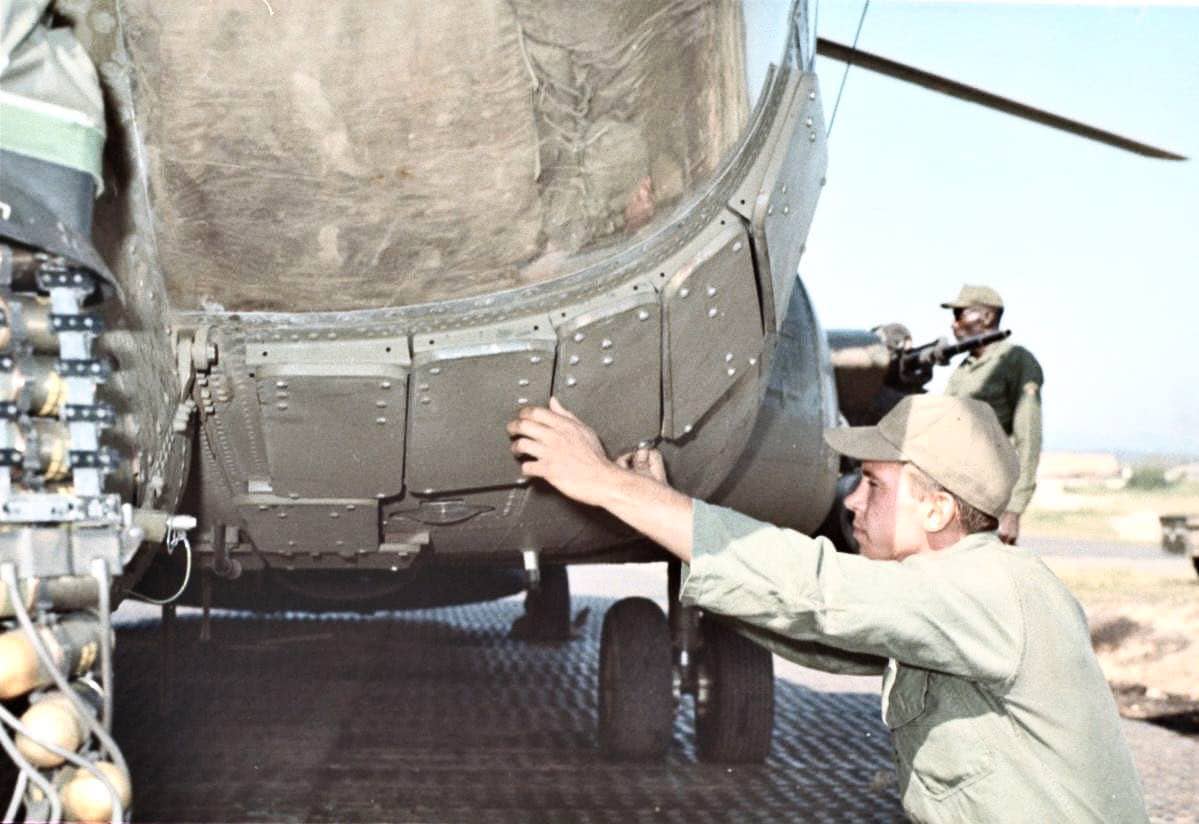
Camp Radcliff was established in late August 1965 by the 70th Engineer Battalion as the base camp for the 1st Cavalry Division. The camp was named after 1/9 Cavalry Maj. Donald Radcliff, the 1st Cavalry’s first combat death, who was killed in August 1965 during Operation Starlite.
To reduce the rotor-blown dust on the landing zone, the advance party was ordered to cut back foliage to ground level by hand, giving the base its nickname of the “Golf Course.” Camp Radcliff was the largest helicopter base in the world at the time, capable of accommodating the division’s 400 helicopters.
ACH-47A Armament
The gunship’s armament was extensive. On the nose was an M5 40mm automatic grenade launcher. The M5 consists of a single M75 grenade launcher mounted in a nose turret, with a hand-controlled sight linked to the turret. It had an ammunition capacity of 150 or 302 rounds, depending on the configuration.
Weapons sponsons were mounted on either side of the ship, each fitted with an M24A1 20mm Hispano-Suiza HS.404 gas-operated autocannon and an XM159 19 tube 2.75-inch folding-fin aerial rocket launcher or an M18 gun pod containing an M134 Minigun with a cyclic rate of 2,000 or 4,000 rounds per minute fed from a 1,500-round drum.
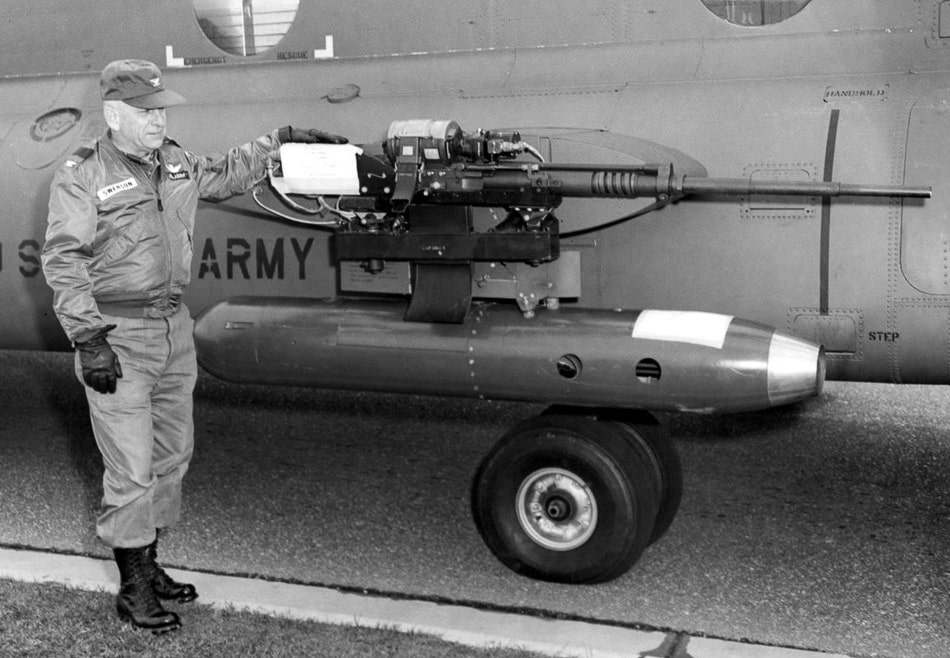
The ACH-47A carried five 7.62×51mm M60D machine guns or .50-caliber M2HB “Ma Deuce” heavy machine guns, two on each side and one mounted on the rear loading ramp. The gunship carried over two tons of expendable munitions to feed all that firepower.
To improve its survivability, Boeing fitted the gunship with armor plating near the front to protect components, and it added plating into the newly designed crew seats, which wrapped around the torso of the pilot and co-pilot.
Stump Jumper
On July 4th, 1966, gunship #64-13151 lost its #2 engine on a gun run and was forced to land in an open field filled with tree stumps. The Chinook suffered significant damage to the underbelly. This forced landing earned it the nickname “Stump Jumper.”
A month later, Stump Jumper was involved in a ground taxi accident with another Chinook at Vung Tau Airfield, and the gunship was destroyed, literally breaking in two. With the destruction of the Stump Jumper, the testing of #64-13145, Co$t of Living at Edwards AFB was stopped, and it was shipped off to Vietnam.
Co$t of Living
On May 5, 1967, Co$t of Living suffered a tragic system failure. While making a gun run in the vicinity of Bong Son, the retaining pins on one of its 20mm cannons came loose, allowing the gun to swing upwards and fire into the aircraft’s front rotor, destroying the front rotor blades and causing the aircraft to spin to the ground and crash. All eight crew members would perish.
Birth Control
On February 22nd, 1968, Birth Control was in the battle to recapture Hue during the Tet Offensive. While pulling out of a gun run, birth Control came under heavy fire, which caused loss of aft transmission pressure and made an emergency landing in a rice paddy about 600 meters NW of the Citadel walls of the ancient city.
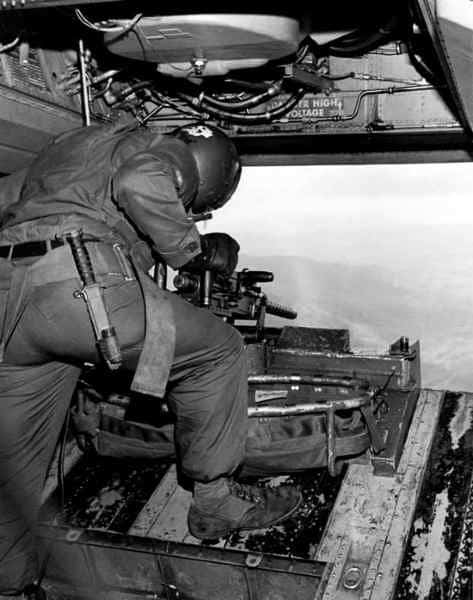
The crew removed the guns from the ship and took a defensive position. Easy Money came to the rescue and positioned herself between the ship and incoming enemy fire. The crew of Birth Control boarded Easy Money and, while attempting to get airborne with the extra weight, started taking hits, which wounded some of the crew.
Easy Money made its way back to nearby Camp Evans. As plans were being made to recover Birth Control, Intelligence reported that NVA mortar crews had destroyed the ship.
Easy Money
With only one gunship remaining and the need for heavy-lift helicopters for the war, the U.S. Army canceled the program. Easy Money finished out the war at Vung Tau as a Chinook maintenance trainer with the Boeing field unit.
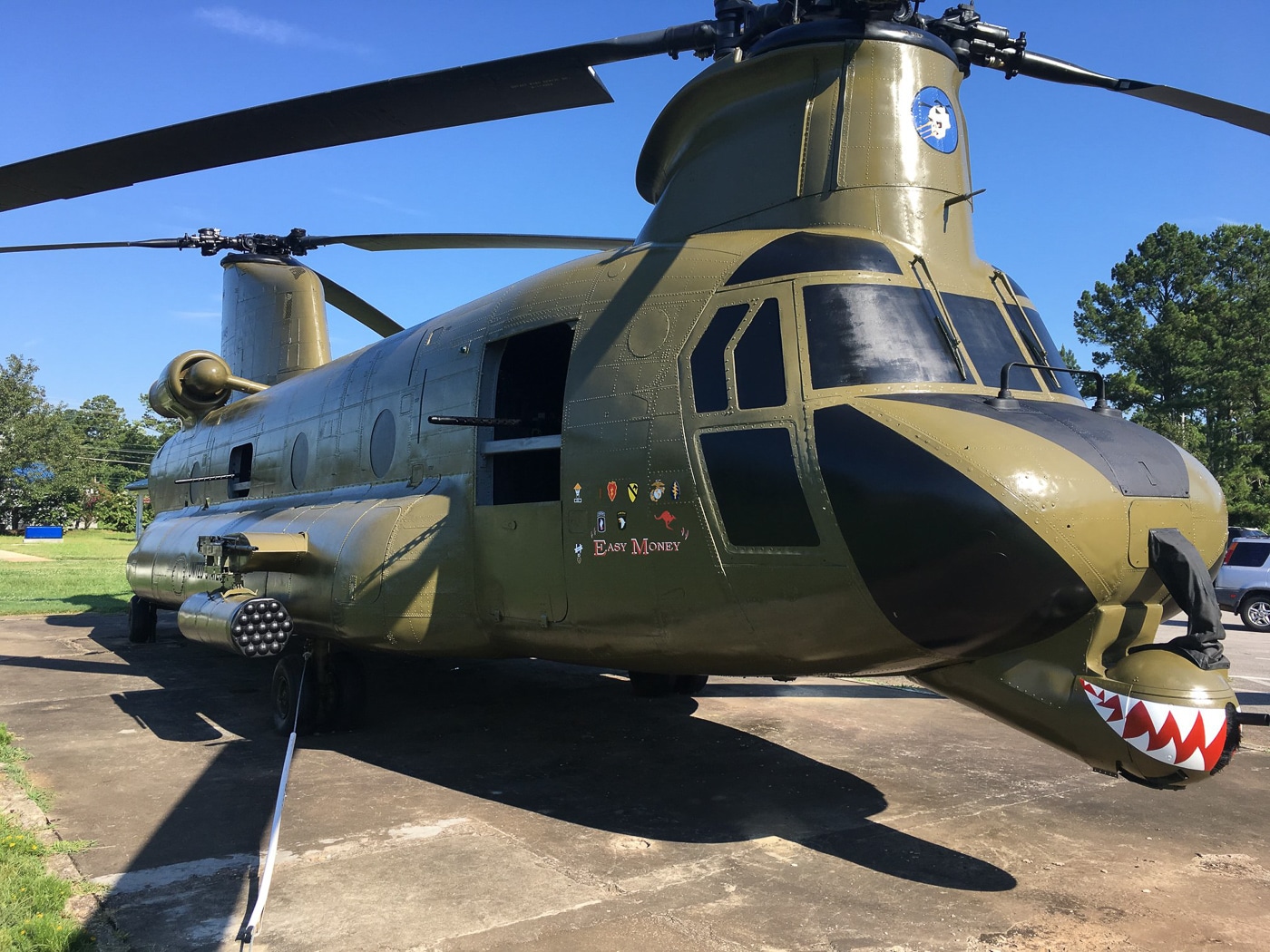
Of the four original gunships, Easy Money was the lone survivor. After the Vietnam War, Easy Money eventually ended up at Fort Eustis, Virginia, where it served as a trainer for the Transportation School Sheet Metal Course. In the late 1990s, it was recognized for its historical significance and rebuilt for a museum display at the Fort.
In May 2000, Easy Money was permanently displayed at the United States Army Aviation and Missile Command/CH-47 Program Executive Office, Redstone Arsenal, Alabama.
Program Successes
Ultimately, the Guns-a-Go-Go program was a success. The troops loved the gunship’s support, and the enemy feared it. During their evaluation period, the gunships destroyed every target they engaged.
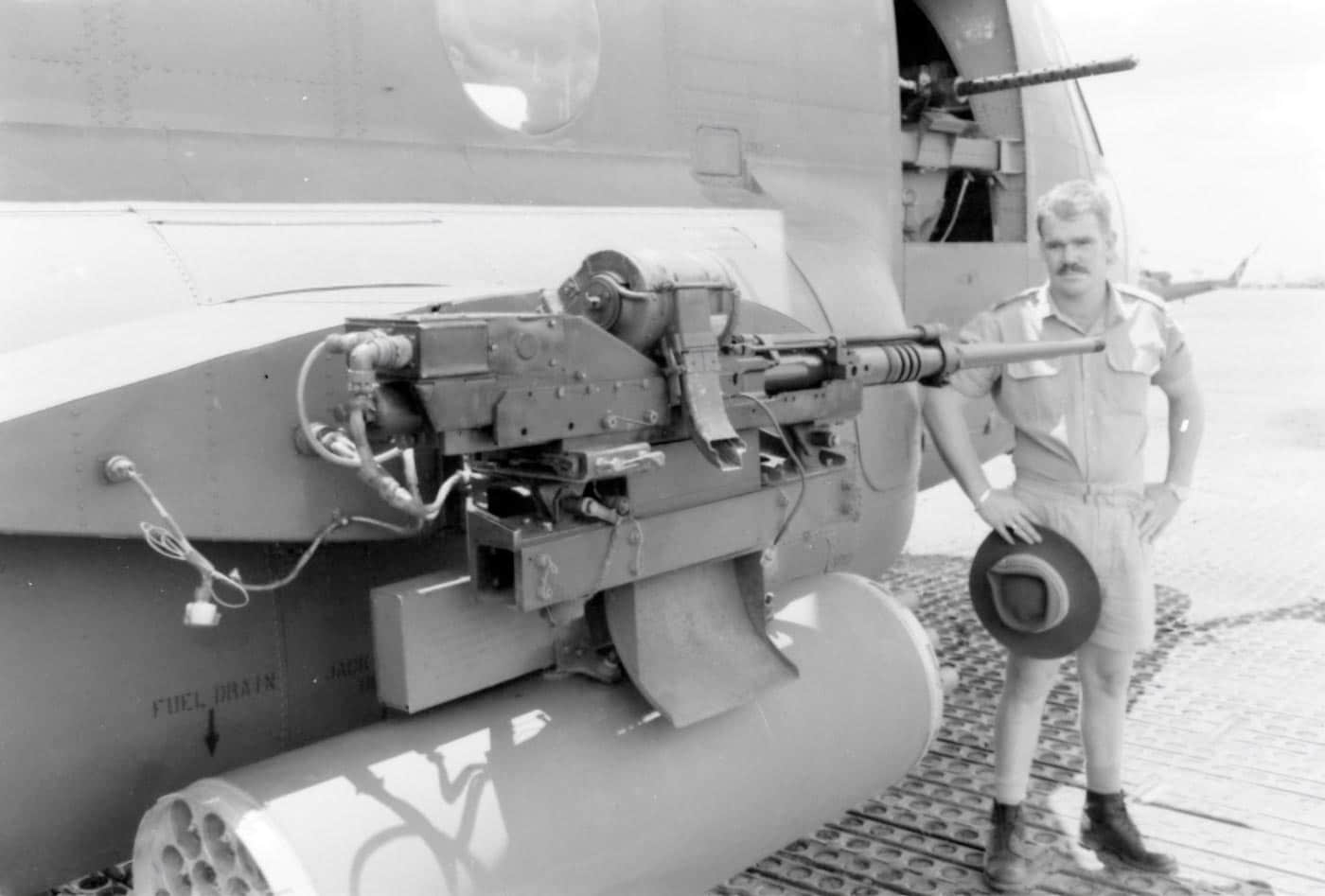
In the words of the Guns-A-Go-Go Commander in Vietnam, Maj. Gen. Tolson:
“Though anything but graceful, it had a tremendous effect on the friendly troops, which constantly asked for its support. From an infantryman’s viewpoint, when the Go-Go Bird came, the enemy disappeared.”
Editor’s Note: Please be sure to check out The Armory Life Forum, where you can comment about our daily articles, as well as just talk guns and gear. Click the “Go To Forum Thread” link below to jump in and discuss this article and much more!
Join the Discussion
Read the full article here








